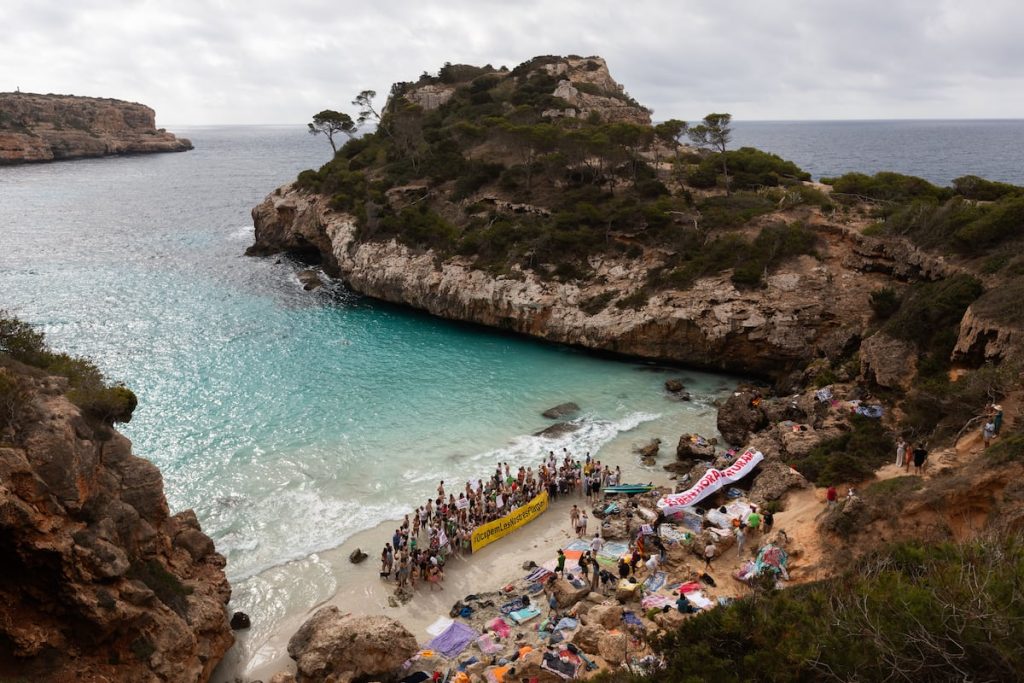Twenty years ago, it was difficult for many to reach Es Caló des Moro, a small cove with crystal clear waters between steep cliffs in the Mallorcan municipality of Santanyí. The location was not marked on road signs and many only found it with directions from friends who had been there before. Last summer, the line to access the cove reached up to three hours and few on the island know of any residents who have ventured there for pleasure in recent years. Leaving a towel and a basket was impossible, the shore was crowded with people taking pictures, the access path had been completely eroded, and drivers trying to avoid the twenty-minute walk from the nearest parking lot congested the small housing area, preventing residents from leaving their homes. Around 300 residents took over the beach this Sunday to highlight the consequences of mass tourism on Mallorca.
The growing feeling of tourist pressure is supported by the latest data from AENA, which revealed that Palma airport welcomed 3.8 million travelers in May, 12.3% more than the same month the previous year. More than 27,000 aircraft movements propelled German and British tourism, primarily. This situation has begun to affect the local population, causing many to refrain from certain activities, such as going to the beach or walking in certain areas that were once common. Statements made by Vox’s parliamentary spokesperson in the islands, Manuela Cañadas, who recently claimed that Mallorcans cannot expect to “go to the beaches in July and August peacefully like they used to years ago,” sparked anger among many residents.
At 8 a.m. this Sunday, groups of friends began to descend the narrow streets of the housing area of Cala S’Almunia carrying umbrellas, coolers, banners, and floaties with the aim of reaching Es Caló des Moro. Jordi Ribas, a resident of Cala Pi, joined to support the idea that Mallorca is “not an amusement park” and that the environment needs to be preserved. Jaume Valentí, a resident of Marratxí, believes that tourism in Mallorca has exceeded what is considered normal and that Mallorcan residents serve tourists instead of tourists improving the living conditions of Mallorcans.
A citizen movement called ‘Mallorca Platja Tour’ was formed on the social network X a few weeks ago, under the slogan ‘Occupying our beaches’, to raise awareness of the situation residents face during the summer months. Es Caló des Moro, a cove that receives 4,000 visitors daily, has lost most of its sand due to the constant influx of tourists. The mayor of Santanyí, María Pons, has urged visitors to let the beach rest, as the local government spends significant resources on maintaining facilities, policing, and cleaning the area due to uncivil behavior by tourists. Around 300 people protested by occupying the entire beach with towels, umbrellas, coolers, and signs reading SOS Residents, to make their concerns visible.
The mayor considers the current situation to be “an aberration”, noting that people take multiple changes of clothing for photos to pretend they have visited the cove on different days. Residents do not go to the cove, and the few who do, go early in the morning. A parking lot located 20 minutes away partially alleviates traffic, but many drivers wait in the area, causing congestion and blocking access. Despite calls to let the cove rest, the local government has decided to expand the parking lot in a contradictory move to alleviate congestion. Many tourists turned back this Sunday upon finding the beach full, highlighting the ongoing challenges of balancing tourism and resident needs in Mallorca.


